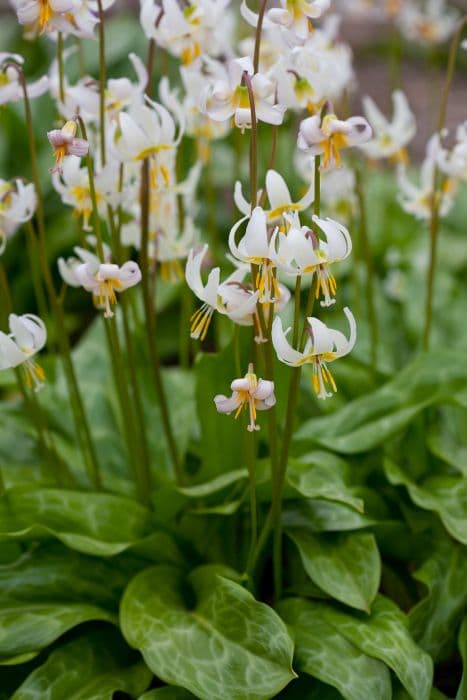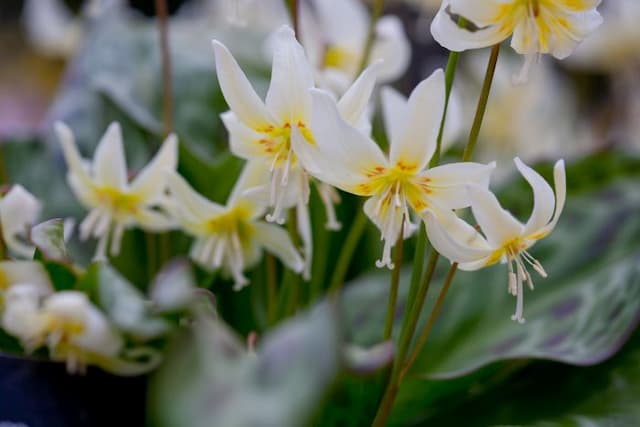Tulip Tulipa 'Bleu Aimable' (5)

ABOUT
The Tulipa 'Bleu Aimable', commonly known as the Tulip 'Bleu Aimable', is a visually striking cultivar exhibiting a unique flower coloration. This cultivar typically features blossoms with a delicate, pastel blue-lavender hue that infuses the petals with an ethereal charm. The soft blue shade is a rarity among tulips, making 'Bleu Aimable' stand out in any garden setting. These tulip flowers have a classic cup-shaped form that gracefully opens from a bulbous base to a wider, flared top. The petal edges may exhibit a slight frill, adding a touch of elegance to the overall bloom. The foliage is fresh green and lance-shaped, forming a dense clump that cradles the flower stems. Each stem usually supports a single flower bud that swells before blossoming into the full, enchanting display of color for which this plant is known.
About this plant
 Names
NamesSynonyms
Blue Aimable Tulip, Blue Lovely Tulip.
Common names
Tulipa 'Bleu Aimable'
 Toxicity
ToxicityTo humans
The common name for Tulipa 'Bleu Aimable' is tulip. Tulips are generally considered to have low toxicity to humans. However, all parts of the tulip contain alkaloid and glycoside compounds which can cause irritation when ingested. If ingested in large quantities, tulip bulbs, in particular, can lead to digestive upset, including nausea, vomiting, and diarrhea. Contact with the bulb can also cause allergic reactions and skin irritation in some individuals. It is uncommon for severe poisoning to occur from tulips, but it is advisable to handle them with care and prevent young children from ingesting any parts of the plant.
To pets
The common name for Tulipa 'Bleu Aimable' is tulip. Tulips are considered to be toxic to pets, especially cats and dogs. The plant contains allergenic lactones and other alkaloids which can cause gastrointestinal upset if ingested. Symptoms of tulip toxicity in pets might include drooling, vomiting, or diarrhea. In severe cases, if a substantial amount of the bulb is consumed, it can lead to more serious conditions such as increased heart rate and changes in respiration. Contact with the bulb may also cause dermatitis. It is essential to keep tulip plants and bulbs out of reach of pets and seek veterinary attention if you suspect your pet has ingested any part of a tulip plant.
 Characteristics
CharacteristicsLife cycle
Perennials
Foliage type
Deciduous
Color of leaves
Green
Flower color
Lavender
Height
1-2 feet (30-60 cm)
Spread
3-6 inches (7.5-15 cm)
Plant type
Bulb
Hardiness zones
3-8
Native area
Central Asia
Benefits
 General Benefits
General Benefits- Aesthetic Appeal: Tulipa 'Bleu Aimable', commonly known as Tulip, is highly prized for its unique lavender-blue blooms that add a striking color contrast to any garden.
- Pollinator Attraction: Tulips are known to attract bees and other pollinating insects, essential for the fertilization of many plants in the garden.
- Easy to Grow: Tulips, including the 'Bleu Aimable' variety, are typically easy to plant and maintain, ideal for both novice and experienced gardeners.
- Spring Blooms: As a spring-flowering bulb, Tulips provide one of the first displays of color in the garden after winter, heralding the approach of warmer months.
- Landscape Design: Tulips are versatile for garden design, adding height, color, and structure to flower beds, borders, and container displays.
- Cut Flowers: Tulips have long been prized as cut flowers due to their vivid colors and long vase life, making them popular for bouquets and flower arrangements.
 Medical Properties
Medical PropertiesThis plant is not used for medical purposes.
 Air-purifying Qualities
Air-purifying QualitiesThis plant is not specifically known for air purifying qualities.
 Other Uses
Other Uses- Photography Subject: The Bleu Aimable tulip, with its unique hue, serves as a stunning subject for photographers, especially those specializing in botanical and nature photography.
- Art Inspiration: Artists may use the distinctive color and form of the Bleu Aimable tulip as inspiration for paintings, drawings, and textile designs.
- Educational Tool: Botany educators can use the Bleu Aimable tulip to teach about hybridization, plant genetics, and the diversity of flower forms and colors.
- Garden Themed Events: The Bleu Aimable tulip can be a thematic focal point for garden parties or events that are centered around floral displays and gardening.
- Wedding Decor: The rare and elegant appearance of Bleu Aimable tulips makes them suitable for use in wedding bouquets and as part of the ceremonial decor.
- Culinary Decoration: Although not typically consumed, the petals of Bleu Aimable tulips can be used as a non-toxic decorative element on plates and platters for special dining occasions.
- Color Pigment Source: Historically, the petals of some tulip varieties have been used to create natural dyes, and Bleu Aimable tulips could theoretically be used in a similar way.
- Floral Crafts: The sturdy stems and vibrant petals of Bleu Aimable tulips make them ideal for inclusion in floral crafts such as making wreaths or dried flower arrangements.
- Labeling and Study: Horticulture students use the Bleu Aimable tulip to learn about plant labeling and to practice detailed plant observation and study techniques.
- Theme Gardens: Garden designers might incorporate Bleu Aimable tulips into a blue-themed garden or a historical garden replicating tulip varieties of the past.
Interesting Facts
 Feng Shui
Feng ShuiThe tulip is not used in Feng Shui practice.
 Zodiac Sign Compitability
Zodiac Sign CompitabilityThe tulip is not used in astrology practice.
 Plant Symbolism
Plant Symbolism- Love: The tulip is traditionally a symbol of love and affection. The 'Bleu Aimable' variety, with its unique color, can signify deep, true love and trust in a relationship.
- Perfect Lover: Tulips are often considered a declaration of being a perfect lover, and the 'Bleu Aimable' with its captivating color, may emphasize this notion of an almost idealized, dreamy love.
- Royalty: The rarity and distinctiveness of the 'Bleu Aimable' tulip can be linked with royalty and an air of nobility, similar to how purple is often associated with royalty.
- Tranquility: The cool tones of the 'Bleu Aimable' suggest calmness and tranquility, evoking a peaceful sentiment and the idea of an oasis of calm in a busy, hectic world.
- Uniqueness: Given its unusual blue hue, the 'Bleu Aimable' tulip can symbolize uniqueness and standing out from the crowd. It might be given to someone who is celebrated for their individuality and uniqueness.
 Water
WaterTulip 'Bleu Aimable' requires moderate watering during its active growing phase in the spring. It's best to provide about 1 inch of water per week, which equates to approximately 0.6 gallons for an area of 10 square feet. Water directly at the base of the plant to avoid wetting the foliage, which can lead to fungal diseases. Once the tulip has flowered and the leaves start to yellow, reduce watering as the bulb enters dormancy. Over the summer, when the bulb is dormant, watering is not necessary unless the weather is exceptionally dry.
 Light
LightTulip 'Bleu Aimable' performs best in full sun to partial shade conditions. The ideal spot is where the plant can receive at least 6 hours of direct sunlight per day. Avoid placing it in deep shade, as this will hinder its flowering potential.
 Temperature
TemperatureThe tulip 'Bleu Aimable' thrives in temperatures between 60°F and 70°F during its growing season. It is hardy and can survive winter temperatures as low as 20°F. The bulbs require a chilling period of 12-14 weeks at 40°F to 45°F to produce blooms in the spring.
 Pruning
PruningTulip 'Bleu Aimable' does not require traditional pruning, but spent flowers should be deadheaded after blooming to prevent the plant from expending energy on seed production. Leave the foliage in place until it naturally dies back to allow the bulb to gather energy for the next season. Typically, this means leaving the leaves until they yellow and wither, which is usually by early summer.
 Cleaning
CleaningNot needed
 Soil
SoilTulips prefer well-draining soil mixed with compost or well-rotted manure, a balanced mix of sand, silt, and clay, with a pH of 6.0 to 7.0.
 Repotting
RepottingTulips, being perennial bulbs, do not need repotting; they should be planted in the ground or in containers with adequate drainage every autumn.
 Humidity & Misting
Humidity & MistingTulips do well in average outdoor humidity and do not have special humidity requirements.
 Suitable locations
Suitable locationsIndoor
Ensure bright light, cool temperatures, and plant in well-draining soil.
Outdoor
Plant bulbs in fall, full sun to partial shade, well-draining fertile soil.
Hardiness zone
3-8 USDA
 Life cycle
Life cycleTulipa 'Bleu Aimable', commonly known as Bleu Aimable tulip, begins its life cycle when a bulb is planted in the fall before the first frost. The bulb remains dormant underground through the winter, experiencing a necessary chill period to stimulate the next stage of growth. As temperatures warm in the spring, the bulb sends up shoots, leaves, and a single flower stalk, which then blooms into the characteristic blueish-purple hued tulip. After flowering, the plant enters a phase of energy accumulation, where the leaves photosynthesize to replenish the bulb's energy reserves. Once the leaves yellow and die back, the plant enters a period of dormancy again through the summer months. The cycle repeats when the bulb is triggered to restart the growth process the following spring, or it may produce offspring bulbs which can be separated and planted to start new plants.
 Propogation
PropogationPropogation time
Spring
Propogation: Tulipa 'Bleu Aimable', commonly known as the Tulip 'Bleu Aimable', is most effectively propagated through the division of its bulbs. The best time for this practice is in late summer to autumn, when the foliage has died back, and the bulbs have completed their annual growth cycle. To propagate, carefully lift the tulip bulbs from the soil after the leaves have yellowed and died back. Gently pull apart any bulblets, which are the small bulbs that form at the base of the mother bulb. These can be replanted immediately or stored in a cool, dry place until the planting season. Plant the bulbs about 6 to 8 inches (15 to 20 centimeters) deep, placing them in well-drained soil with the pointed end facing upwards. This simple vegetative method ensures that the unique characteristics of Tulip 'Bleu Aimable' are preserved in the new plants.








